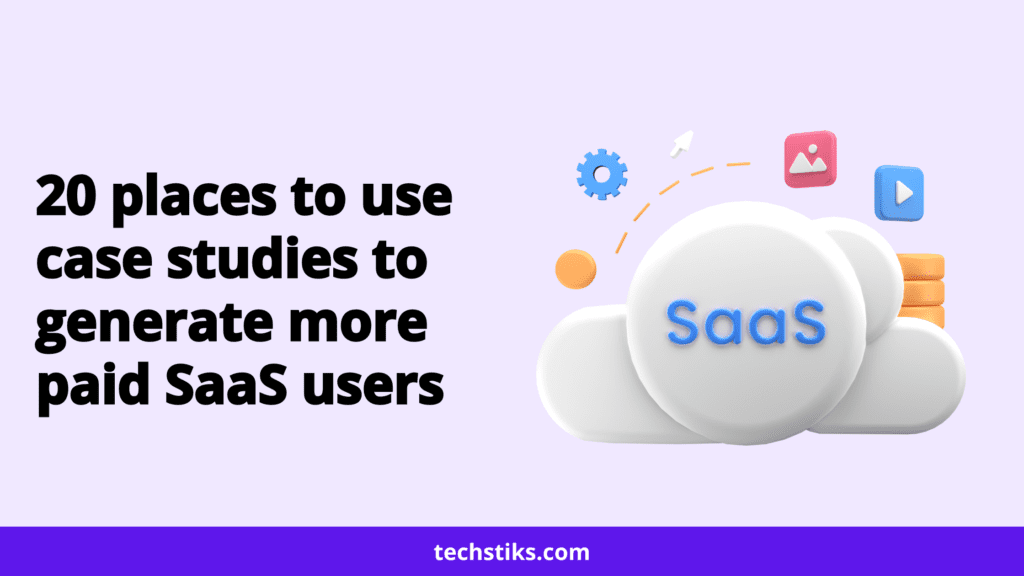When it comes to acquiring more paid SaaS users then one type of content that can help you the most is client case studies.
When you showcase your successful client stories to your potential clients then it has as a great impact on their purchase decision – their confidence in your product increases and they are more likely to make a purchase.
So, using case studies is an effective strategy for SaaS businesses to acquire more paid users.
But one questions that bugs most SaaS owners is – how exactly to use case studies to acquire more users?
In this article, you’ll learn the same.
What you’ll learn in this article
Why to use case studies for your SaaS business?
A well-crafted case study doesn’t just focus on the success story but also addresses the initial challenges, the process of implementing your solution, and the measurable results achieved.
It’s a compelling storytelling tool that resonates with potential customers looking for evidence before making a purchasing decision
Below are the main reasons why you should be leveraging case studies for your SaaS business:
Showcasing Success Stories
Case studies highlight how your SaaS solution has helped a specific client overcome challenges and achieve their goals.
They serve as real-life success stories, demonstrating the value and effectiveness of your product.
Building Credibility
When potential customers see how your SaaS product has benefited others, it builds credibility and trust in your brand.
They can visualize the potential outcomes for their own businesses.
Addressing Pain Points
Case studies often focus on specific pain points your target audience might face.
When prospects identify with these challenges, they’ll be more inclined to explore your solution if they see it has successfully addressed similar issues for others.
Evidence-Based Marketing
Unlike generalized marketing claims, case studies provide tangible evidence of your SaaS product’s performance.
They showcase real data, metrics, and testimonials, making your marketing more persuasive.
Educational Purposes
Case studies can also educate your audience on how to best utilize your SaaS product.
They might offer insights, strategies, or innovative ways your product can be applied.
Sales Enablement
Sales teams can leverage case studies as powerful tools during the sales process.
They provide concrete examples to illustrate how your SaaS solution can directly benefit potential customers.
Differentiation
In a competitive market, case studies set you apart from your competitors.
They highlight your unique selling propositions and demonstrate how your SaaS solution stands out.
Here are 20 places to use case studies to attract and convert potential clients:
Website Homepage
The first place you can use your case study is on your homepage.
You can showcase a prominent case study on your homepage to immediately grab the attention of visitors.
For example, you can feature a case study on your homepage, demonstrating how your software helped a company achieve results.
Landing Pages
The second best place to use your case study is on landing pages.
Create dedicated landing pages for each case study. Tailor the content and messaging to the specific audience you want to target.
For instance, a project management SaaS might have a landing page focused on how their software improved workflow efficiency for marketing teams.
Product Pages
You can embed relevant case studies on your product pages.
If you offer different packages or solutions, include case studies that correspond to each.
For example, a CRM SaaS could include a case study highlighting how their Enterprise plan benefited a large corporation.
Pricing Page
On your pricing page, display case studies that emphasize the value of your paid plans.
Show how businesses achieved a strong return on investment (ROI) by choosing your premium options.
Blog Posts
Write blog posts that explore the challenges faced by your ideal customers and use case studies to illustrate how your SaaS solution solves those problems.
This adds depth and credibility to your content.
Email Marketing
Share case studies with your email subscribers.
Send out newsletters that feature success stories to nurture leads and encourage them to consider your paid offerings.
Social Media
You can use social media platforms to share snippets of case studies with links to the full stories.
Platforms like LinkedIn are particularly effective for reaching a professional audience.
Video Testimonials
Convert written case studies into video testimonials.
Record your satisfied customers discussing their experiences and results.
These videos can be shared on your website, YouTube, and social media.
Webinars
Host webinars or online events where you discuss a specific case study in detail.
This interactive format allows you to answer questions and provide additional context.
Podcast Episodes
If you have a podcast related to your industry or niche, feature case study discussions.
Share stories of businesses that overcame challenges with your SaaS product.
Email Signatures
Include a link to a case study in your email signature.
This subtle addition can prompt recipients to explore your success stories.
Thank You Pages
After users sign up for a trial or subscribe to your service, redirect them to a thank-you page that highlights a case study. This reinforces the value of your offering.
Customer Onboarding
During the onboarding process, share case studies with new customers.
Highlight how your software has benefited businesses similar to theirs, setting expectations for the value they’ll receive.
Support Pages
On your support or help center pages, include case studies that demonstrate how your SaaS solution resolved common user issues.
This can be reassuring for existing customers facing challenges.
Email Campaigns
Incorporate case studies into your email drip campaigns.
For instance, send a series of emails that walk potential customers through a case study from the problem to the solution, and finally, the achieved results.
Testimonials Page
Create a dedicated page on your website for customer testimonials and case studies.
Organize them by industry or use case to make it easy for visitors to find relevant stories.
CTAs in Content
Include calls-to-action (CTAs) in your blog posts and other content, encouraging readers to explore related case studies.
For example, a CTA at the end of a blog post might say, “Read how [Company] increased conversions by 40%.”
Newsletters
Share case studies in your company newsletters.
Regularly featuring success stories can help you maintain engagement with your audience.
Partnerships and Collaborations
If you have partner companies or affiliates, collaborate on case studies that showcase how your SaaS product complements their services.
This can expand your reach and attract new users from their networks.
Conferences and Trade Shows
When attending or sponsoring industry events, use case studies as part of your presentation or booth materials.
Showcasing real-world successes can make a strong impression on event attendees.
CONCLUSION
You have learned 20 different ways you can leverage a single case study to acquire more users.
A single case study gives you so many opportunities to showcase the potential of your product to your prospects.
The more you leverage these opportunities, the more growth your business will experience.




